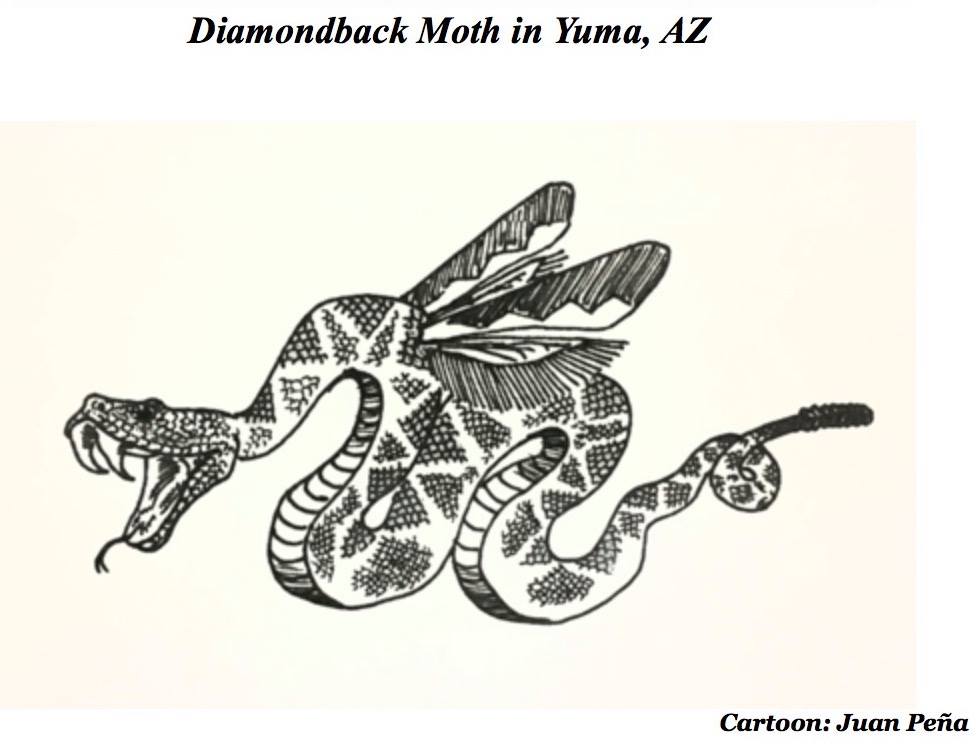Seems like every year around this time I make the comment that insect pressure this season was more unusual than normal.
Well, this year it’s true. A quick look at both recent and historic data on pest abundance recorded from our University
of Arizona research plots and areawide and pheromone/sticky traps suggests that insect pressure this fall was historically
low for most key pests. For the supporting data see Pest Abundance on Desert Produce and Melon Cops in Fall 2018.
Whitefly/CYSDV: Areawide, whiteflies in fall melons were again historically light and were very similar to last season.
Accordingly, CYSDV incidence at harvest in cantaloupe fields was as low as we’ve seen it since the virus first showed up in 2007.
The virus incidence at harvest in over 30 commercial plantings was very low in most fields, with just a couple of hot spots were observed
in Texas Hill and Tacna. For the most part, whiteflies were similarly light in produce crops with an occasional flare-up in some isolated
areas. Data from our untreated broccoli/cauliflower plots at the Yuma Ag Center (YAC) show that colonization by whitefly nymphs was the
lightest we’ve seen in 10 years. Beet armyworm, cabbage looper, and corn earworm: Very light worm year in Yuma. Population abundance
on untreated lettuce at the YAC this fall was the lightest we’ve seen since 1996. Similarly, numerous reports from PCAs suggest that fewer
sprays were applied this fall, and in some recent fields spray intervals have been stretched to almost 30 days. This lower activity is likely
due to the cool nighttime temps in Oct and Nov., and activity appeared to slow down dramatically in October, following the back-back tropical
storms we experienced. Although corn earworm trap catches in October were the highest, we’ve seen recently, larval abundance in head lettuce
at YAC and in commercial fields was light. Diamondback moth (DBM): DBM was not a problem again for local desert growers in 2018; about what
we normally expect for the fall. We received no calls from PCAs reporting difficulty in controlling populations. Areawide pheromone trapping
showed that DBM trap captures began in early September and trended very similarly to 2017 numbers. At YAC, the larval populations were the
lightest we’ve seen since 2001, even though moth numbers were similar to 2017. Caution: DBM is usually a spring pest in the desert, so keep
your eyes open for larvae and damage on those Feb-Apr cole crops and late seed crops. Thrips: Similarly, the western flower thrips pressure was
light this fall; significantly lighter than the previous two falls. These lower population levels were likely a result of rains from tropical
storm in early October. Bean thrips abundance was also lighter in 2018 relative to the previous two seasons. Scarring damage was negligible in
untreated lettuce plots. Flea beetles: Beetle activity at YAC was considerably lower than what we “normally” experience in the fall. However,
we’ve had reports of sustained flea beetle movement onto commercial lettuce (with significant feeding damage) from alfalfa and other sources within
the last several weeks. Bagrada bug: Adults and their feeding was again almost non-existent. For a fourth consecutive year, bagrada adults
were so light in my research plots that we were not able to conduct any efficacy trials. A few sightings in late-September and early October
from PCAs of adult presence in transplanted crops, but the populations disappeared following a single pyrethroid chemigation. So, it was truly an
unusually low insect year. Can’t wait to see what next year brings us. Have a Merry Christmas!
Can you Name the INSECT below?

Areawide Diamondback Moth Trapping Network
In response to the recent outbreaks of Diamondback moth (DBM), Plutella xylostella in Yuma, we have established a pheromone trap network designed
to monitor the activity and movement of adult populations of DBM. PCAs have had difficulty controlling DBM in cabbage, broccoli and cauliflower since
October 2016. Traps have been placed in Roll, Wellton, Dome Valley, Gila Valley and Yuma Valley in locations where cole crops are presently being
grown or in areas where infestations were known to occur in the fall.
Click here to see results of DBM pheromone trap network.
Click here to see results of DBM pheromone trap network.
Remember, When in Doubt . . . . . “SCOUT”

|




